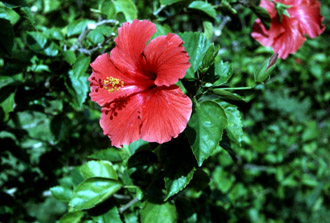Medicinal Purposes
 This
flower has incredible medicinal purposes (many I was not aware
of!). In Southern Asian medicine they add the medicinal parts of
the plant to food. The roots of the Hibiscus rosa-sinenesis
are used for cough treatments. The leaves of the Hibiscus
rosa-sinensis are used as a laxative. The flowers of this
plant may be used if you become infected with a type of
E. Coli causes diarrhea.
This
flower has incredible medicinal purposes (many I was not aware
of!). In Southern Asian medicine they add the medicinal parts of
the plant to food. The roots of the Hibiscus rosa-sinenesis
are used for cough treatments. The leaves of the Hibiscus
rosa-sinensis are used as a laxative. The flowers of this
plant may be used if you become infected with a type of
E. Coli causes diarrhea.
The Hibiscus rosa-sinensis has anti-diarrhea properties. The flowers are also used for fertility treatments. In India, the flowers of the Hibiscus rosa-sinenesis are ground with henna and used as a female contraceptive. The powder of the henna and the flower are taken once a day for three to seven days to avoid contraception. There are also extracts used to effect male fertility. There has also been information found in Ancient Indian literature stating that the Hibiscus rosa-sinensis may have positive effects on heart disease.
There was a study concerning non obese diabetic rats. This
study looks at type one diabetes in rats, which is closely related human
diabetes. The study used healthy leaves from the Hibiscus rosa-sinensis,
the extracts were put in ethanol and given to the rats. There were two
generations of rats that were given the extract to help test the effects of the
plant against diabetes. The hibiscus seemed to have an effect on the insulin
levels of the rats. The generation of rats that was given a higher dosage of the
extract at roughly 200 mg/kg, the extract seemed to have a greater effect on
insulin levels. The extract may be one of the future drugs for diabetes; however
it was not proven that the extract was the main reason for why the insulin
levels dropped in the rats. If the extract was, this could have a major impact
in the near future becoming a natural way to treat diabetes. In India, the
Hibiscus rosa-sinensis is used as an herb to treat colds, to help wound
healing, and help with damaged/inflamed tissues.

There was also another study done to test the wound healing capabilities of the flower. They used rats in this study who weighed between 200-250 grams, they placed the rats under anesthesia and the rats were given wounds. 50 grams of the flower were used and it was suspended with 200 milliliters of ethanol, it was then suspended for a couple of days. The solution was filtered; the filtrate was placed into a water bath. The clear residue that was leftover was given to the rats. The control group in this study was only given around 100 milliliters of water; the test group on the other hand was given 120 milligrams of the extract per 100 milliliters of water. The test group’s wounds were smaller than size that the control group that was just given water. After the 15th day, the test group’s wounds had epithelialized faster than the control group’s wounds. The healing properties were thought to be tied to the hypoglycemic effect that the extract has, however it is not proven that is the case.
To visit the fact page click here!
To go back home click here!
